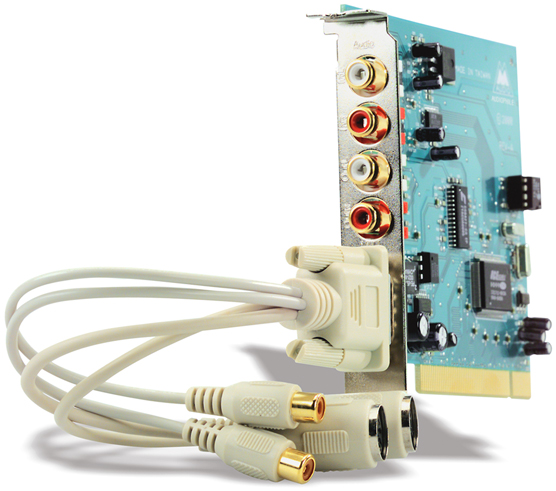- PCIe: PCIe interfaces are inserted into one of the PCIe slots located inside your desktop computer’s case.
- USB: USB 2.0 and 3.x interfaces are the most common types of audio interfaces, with options starting under $100.
- Thunderbolt (USB-C): Thunderbolt has gone through several iterations since its inception. The current version is Thunderbolt-3 or USB-C. Thunderbolt offers speeds that are considerably faster than PCI and USB options.
PCIe interfaces
Peripheral Component Interconnect (PCI) is the old standard for getting audio into and out of a computer. This technology consists of a slot into which you place a card containing the audio transfer components. PCI Express (PCIe) replaced the original PCI slot in computers starting in 2004 and it has essentially replaced them in any computer you’ll find working today (or at least any computer capable of recording music). PCIe had an advantage over the other interface types because of the fast transfer speed of PCIe technology. This type of interface isn’t without its problems, though:- Many computers (for example, laptops and all Macs except the Mac Pro) don’t have a PCIe slot.
- Because PCIe technology is changing, all cards don’t fit in all computers, so make sure that the PCIe interface that you’re considering can fit into your computer.
- Separate sound card with no analog inputs and outputs: In this case, you need to buy separate preamps, direct boxes, and analog-to-digital (AD) and digital-to-analog (DA) converters. For most home recordists, the separate-sound-card route isn’t the best solution. In fact, even for the pros, this isn’t the most popular choice—so much so that this option is quickly falling from the marketplace. This figure shows examples of PCIe sound cards.
 A PCIe sound card doesn’t contain analog inputs or outputs, so you need to buy separate components to use this type of card for audio recording.
A PCIe sound card doesn’t contain analog inputs or outputs, so you need to buy separate components to use this type of card for audio recording.- Analog inputs and outputs within the card: Having the analog connection located in the card used to cause interference with the other components in the computer’s housing (such as fans and hard drives), which caused low-level hums in the recorded audio (not a sound you would want, I can assure you). This is generally no longer the case unless you buy a really inexpensive card, but the bad rap led buyers to shy away from this approach and it has become uncommon as a result. You can find some less expensive audio interfaces configured this way, but the higher end of the market has generally abandoned it. The following figure shows an example of a PCIe card with analog connections.
 Some PCIe interfaces often come with analog connectors run from the computer.
Some PCIe interfaces often come with analog connectors run from the computer.- Analog inputs and outputs housed in a separate box: This box is called a breakout box. Because of the low-level hum problems in the early interfaces, most manufacturers of PCIe-based audio interfaces put their analog circuitry in a separate box with a cord attached to the PCIe card. One advantage to this — besides eliminating the hum in early models — is that you can tweak the input and output levels without having to use a software menu. The dials for the levels are placed on the breakout box within easy reach, as shown.
 A PCIe interface with a breakout box for the analog components is the preferred form of PCIe interface.
A PCIe interface with a breakout box for the analog components is the preferred form of PCIe interface.If your preferred audio recording computer doesn’t have a PCIe slot, don’t worry (or don’t bother adding one). Thunderbolt and USB are both excellent technologies to use for recording music.
USB interfaces
USB interfaces (see the following figure) come in two varieties: those using USB 2.0, and those using USB 3.0. Most computers have at least one USB port. USB is a great option for your audio interface. They can be inexpensive and offer a variety of input/output configurations.Beware of used USB 1.1 interfaces. The latency (delay between the sound entering the interface and exiting your speakers) is too great to keep from being frustrating. You can find decent USB 2.0 and USB 3.0 interfaces for very little money, often starting at about $100 (USB 2.0), though they can run as much as $1,000 (USB 3.0), depending on the manufacturer and the number of tracks and other options they include.
 A USB interface connects to your computer’s USB port.
A USB interface connects to your computer’s USB port.Thunderbolt interfaces
Though it would be a stretch to say that Thunderbolt has reinvented audio recording, it does offer some benefits that makes it better than either PCIe or USB.Compared to USB, Thunderbolt offers eight times faster transfer speed and the ability to chain a variety of devices through the same port without any loss of speed. This means you can have more analog inputs and outputs than USB.
Compared to PCIe, Thunderbolt connectivity is more available—you can find them on laptops as well as on desktop computers. There are also many more interface options to choose from.
Thunderbolt audio interfaces tend to be more expensive than USB, not because of the technology, but because these interfaces often include better analog components, such as preamps, and more inputs and outputs. Expect to spend at least $500 for two input channels and $1,000 and more (often much more) for higher counts.
Quite a few audio interfaces have both Thunderbolt and USB 3.0 ports. If you’re unsure of which to choose, or you plan to upgrade your computer from USB to Thunderbolt, these interfaces are excellent options.





